Intel Alder Lake-H Core i9-12900HK Review: MSI's Raider GE76 Goes Hybrid
by Brett Howse on January 25, 2022 9:00 AM EST- Posted in
- CPUs
- Intel
- MSI
- Laptops
- Alder Lake
- GE76 Raider
- 12th Gen Core
- Alder Lake-H
Platform Power
Intel’s H-Series processors slot into the 45-Watt class, and have been a staple in performance laptops for years. But with Alder Lake, Intel is now specifying both a base power – what we used to consider Thermal Design Power (TDP) – and maximum turbo power, which has also existed for a long time, but was never formally provided. In theory, a processor would get up to its maximum boost power, which we called Power Level 2 (PL2), and then after a certain amount of time, it would go down to its base power, which we called Power Level 1 (PL1).
That model has been thrown out the window in recent years though. Although the numbers are still relevant, what both AMD and Intel allow manufacturers to do is almost treat their mobile processors as their desktop counterparts. As long as you can cool it, you can realistically throw as much power at the processor as you want, as long as you don’t exceed PL2.
In the thin and light notebook segment, that could mean a normal 15-Watt processor will run at 23 Watts sustained when the user puts the device in its highest performance mode, while in a battery saving or silent mode, the processor will still allow short bursts up to its PL2, but then quickly settle down to its PL1 level to avoid excess battery drain and noise.
In the H-Series, that still happens as well. But thanks to the larger cooling systems, especially in a system like the MSI Raider GE76 that Intel has provided, the cooling system can handle far more than the PL1, so in the interests of performance, the processor is run well over 45 Watts.
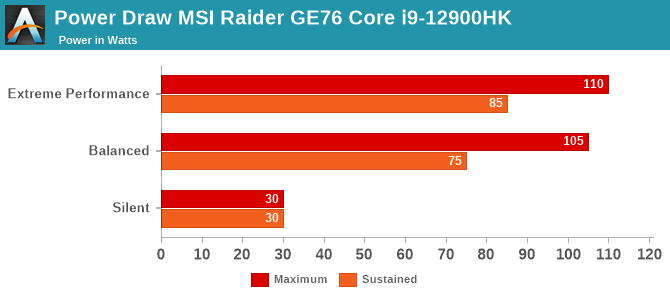
Performing a stress test on the MSI Raider GE76 proves this point very well. When the system is in its maximum performance mode, the processor initially ramps up to an almost insane 110 Watts for a brief moment, and then settles in at a still high 85 Watts for sustained operation.
In its balanced mode, the system brings PL1 down to around 75 Watts, which is still well over the 45-Watt base rating of this processor. Performance will be slightly lower, but so will the noise.
In the Silent mode, MSI drops the power level way down to just 30 Watts, so performance will be impacted significantly, although power consumption grows at a far faster rate than performance, so you don’t lose as much performance as you may think. To see just how big of a drop that is, Cinebench R20 was run in Silent Mode. The result was 3494 versus 6869 in the maximum performance mode. That is 49% less performance for 65% less power, and it is actually less power than that as well because MSI disables the PL2 completely in Silent mode, meaning the device peaks at just 30 Watts instead of 110 Watts.
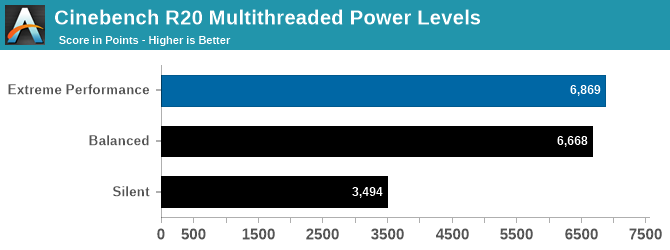
Cinebench runs pretty quickly, so even in Balanced mode the processor is still closer to PL2 than PL1 by the time the test is finished, which is why the scores are so close. On a longer benchmark the difference would be increased, but not significantly, since the sustained power level is similar between the top two modes. If you need that last few percentage points of performance, and do not mind the increased noise, it is available.
Intel and MSI are not the only two to play around with power levels. Pretty much every performance notebook will have some sort of setting to change the power levels and noise. The ASUS G513QY with the AMD Ryzen 9 5900HX has a similar system, and it also draws around 85 Watts in its maximum performance mode on a 45-Watt processor. Really, it comes down to cooling. If you have sufficient cooling, you can extract more performance. The downside is often noise, although that is also dependent on the cooling system design and the size of the notebook.
Multitasking
One of the key ideas around Alder Lake is that it offers six P-Cores and eight E-Cores. Windows 11’s thread scheduler should take advantage of the E-Cores to move intensive workloads to when that task gets moved to the background in Windows, and as such system responsiveness should be improved. Seat of the pants impressions confirm this. With a heavy load running, the system stays responsive. Apps continue to open quickly, and the in-app performance is still quite strong.
To give a more analytical look at the difference, a test was created to simulate a workload where an intensive task was shuffled to the background, and then several apps were run in the foreground and the performance measured. To achieve this, Handbrake was set to transcode a long 1080p video to 720p using the x264 software encoder. Then, that task was shuffled to the background, and both PCMark 10’s Modern Office test suite was run, as well as Cinebench R20. Performance was measured for PCMark 10, Cinebench, and Handbrake to get a feel for how the system was handling the intense load.
This test was then replicated on the ASUS G513QY with AMD’s Ryzen 5900HX and Radeon RX 6800M, as well as a MSI system with the Intel Core i9-11980HK and RTX 3060. The absolute results are not the main concern, but rather the percentage changes from running the tests individually. PCMark 10, as an example, leverages the CPU, GPU, memory, and storage, so it is a good example of a real-world test, but the GPU performance is significantly different on these three systems. Ideally, we would be able to keep all the components the same except the CPU, but we must work with what is available, unlike with desktops. That is why Cinebench was also tested, since it is purely a CPU test and does not leverage the other subsystems like memory or storage.

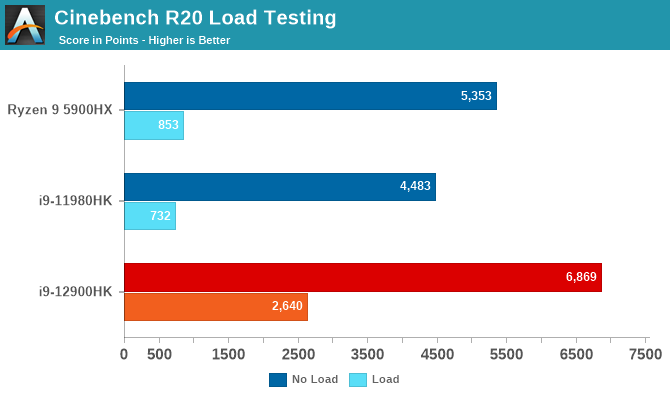
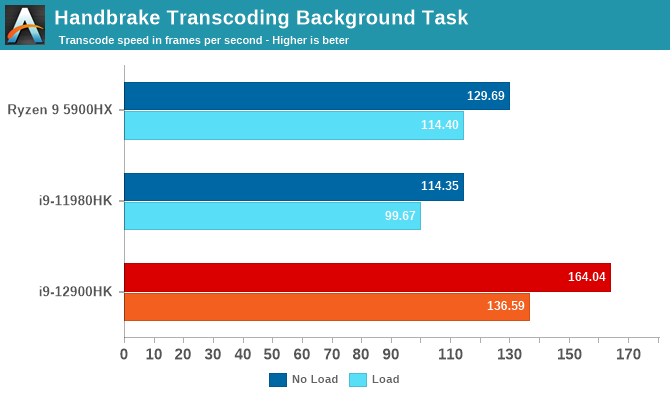
The results are very interesting and prove that Intel’s new Thread Director, coupled with Windows 11, makes a big difference in terms of usability. On PCMark 10, all the systems dropped in performance the smallest percentage, as this test is not just about the CPU, but the Alder Lake Core i9-12900HK dropped the least, with an overall result that was 82.6% of the original unloaded result. The Tiger Lake system was only able to achieve 61.9% of its original result, while the AMD system fared better at 75%.
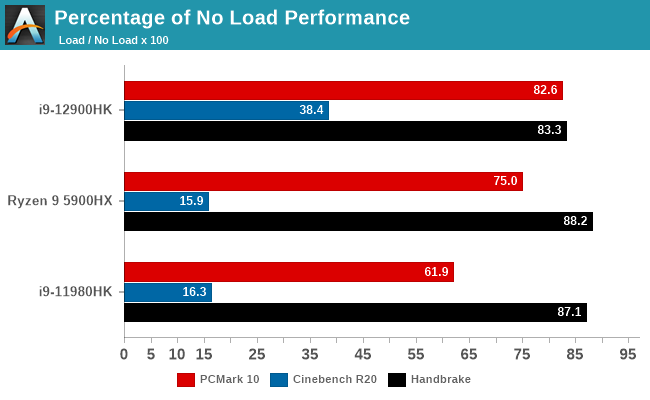
Cinebench though was a different story, with both the Ryzen 9 5900HX and the Tiger Lake i9-11980HK only able to achieve about 16% of their original result, whereas the new Alder Lake system was still able to net 38.4% of its original score while the system was using every single core to transcode a video.
With Handbrake running in the background, all the systems were slower to transcode, but both the AMD 5900HX and Intel i9-11980HK, thanks to not being able to de-prioritize the background task, finished the transcode with a frames per second average of about 88% of the unloaded transcode would have achieved. The new Alder Lake system could only average 83% of its original frames per second, because that task was deprioritized by Thread Director to free up additional resources for the foreground jobs. That made a sizable difference on the net for all the jobs, especially Cinebench.
The new Thread Director and hybrid design is a big win for usability. No longer does an active task feel like it bogs down the system, leaving the user with an unresponsive computer to deal with. Even with the CPU running at 100% load, active tasks feel quick and net performance is very impressive. Although the Alder Lake system did give up the most performance on the background task, it was only an additional 4% over the Tiger Lake system, while at the same time achieving a much higher result on the foreground task. On Cinebench, the Alder Lake system scored 3.6 times higher than the Tiger Lake platform, while still achieving a transcode that was 1.37 times faster. It is very impressive.


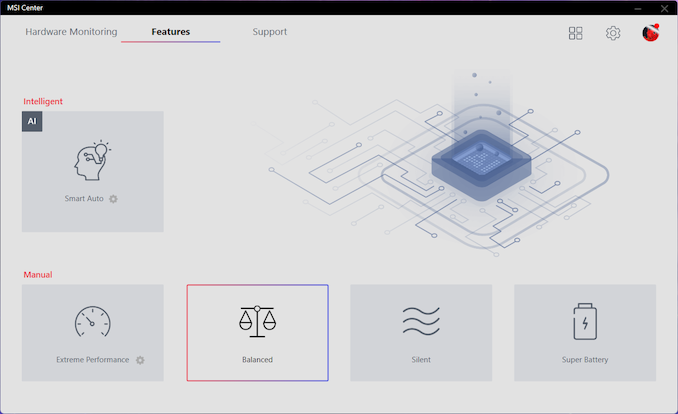








153 Comments
View All Comments
Netmsm - Tuesday, January 25, 2022 - link
"High? not at all" said Patrick Gelsinger.:)))
maroon1 - Wednesday, January 26, 2022 - link
115w is max power for shot period. sustained power consumption is 85w in extreme performance modeAnd 75w when using balanced mode but you lose 3% in cinebench
undervolted_dc - Wednesday, January 26, 2022 - link
... and spec sheet says 45w, but probably during bench are using the full power boost.. and gets benchmarked against 45w ( with boost at 54w) in performance..e cores seems to no help in low performance tasks also.. seems less efficient than amd despite having the complexity to manage hybrid cores in the OS
Spunjji - Thursday, January 27, 2022 - link
It's Intel's strategy ever since they got stuck on 14nm. Prior to that, they kept dropping power while incrementing performance, leading to a progressively improving overall experience (better sustained power, less bulky devices, etc.)Then AMD got back in the game and Intel had to compete somehow, so they started raising their TDP ratings to get benchmarks that look good. The results are easy to see when you look at sites like Notebookcheck that measure performance of large groups of devices: Intel get good benchmarks, but performance drops quickly under sustained use in anything other than a DTR, and there's a massive error bar around the average performance of an Intel mobile CPU because it's dependent on how well the chassis can remove 45W+ of heat (even the Ultra Mobile ones).
sandeep_r_89 - Monday, January 31, 2022 - link
Higher battery capacity doesn't help win benchmarks........bogamia - Tuesday, January 25, 2022 - link
wonder how it would perform against Rembrandt which will presumably offer 30% better mt uplift.Spunjji - Thursday, January 27, 2022 - link
I wouldn't expect to see an increase like that in practice. Rembrandt may be a little faster than Cezanne, but probably not a lot.If you're one of the majority of people who buy a device that's designed to cool 45W sustained, though, then it'll be less of a disappointment than Alder Lake.
vlad42 - Friday, January 28, 2022 - link
Maybe, maybe not. The base clock does appear to have gone up from 1.9 GHz in the 5800U to 2.7 GHz in the 6800U, a 42% increase! Granted, it is possible the 2.7 GHz base clock is only when the chip is in 28W mode - it really was not clear from the slide.We also do not know how much benefit RDNA2 is bringing over Vega in terms of energy efficiency (there may be more thermal/power budget available to the Zen 3 cores), the improvements in 6N vs 7N, or the yield improvements/better binning now that the process is even more mature - 6N is still just a variant of 7N after all.
While I would normally agree with you, we clearly need more information to know for certain. The Ice Lake to Tiger Lake improvements were pretty significant and the changes Intel made look to be fairly similar to what AMD has done here.
Samus - Saturday, January 29, 2022 - link
I agree. I don't think AMD is going to take the IPC performance crown back here unless they can considerably scale up clock speed at the cost of efficiency like a Black Edition part.The fact is all these new CPU's are SO fast that it's Lamborghini's vs Ferrari's. I think people are going to prefer the one that has double the MPG at a virtually unnoticeable performance penalty.
FwFred - Wednesday, February 2, 2022 - link
How does higher clock speed help IPC exactly? Let's just call it single thread performance and leave IPC to microarchitectural discussions.